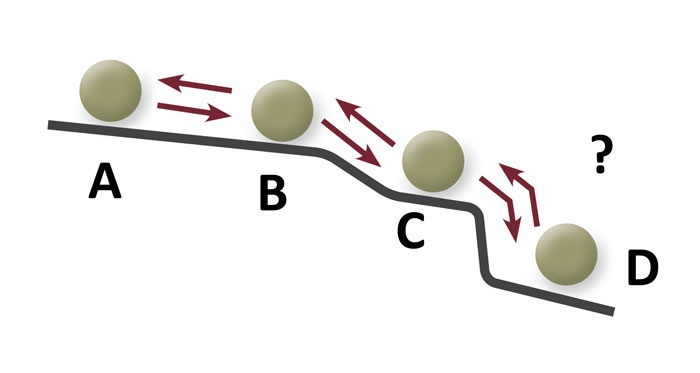Rolling ball model – a slippery slope to poor productivity
Not all changes in land condition occur at the same rate and some are not easily reversible. As demonstrated in the ABCD land condition rolling ball framework below, the susceptibility of land to change in condition, and the ease with which changes can be reversed, depends on the land’s current condition. The long-term cost of losing land condition is very high. The further land condition slips, the more energy and resources have to be invested to get it back. A reduction in land condition reduces carrying capacity and consequently affects long term productivity. For example, letting land condition slip from A to B will reduce carrying capacity by 25%, A to C by 50% and A to D by 75% or more.

Land in condition A is relatively stable. Land that is trending towards condition B can be fairly quickly reverted to condition A by a change in management.
However, land in condition B is susceptible to a quick decline to condition C. Reversing this change may require a major change in management and will take some time to occur.
Land in condition C is very susceptible to falling rapidly to condition D. Land in condition D will not revert to condition C by simply changing management, at least not in any time frame of practical value. Reverting land from condition D to condition C requires a large input of external energy (e.g. mechanical, chemical), and even this may be insufficient if soil condition has been severely degraded.
Where are you paddocks on the ‘slippery slope’?
It is important to distinguish between cosmetic changes in land condition and real changes. For example, well-managed grazing land in condition A with a good density of perennial plants may appear to change to condition B during a run of dry years, but it should quickly resume the classic look of condition A with one good wet season.
A common misreading of land condition is that land in condition C is ‘OK’ because it manages to produce green cover during a run of wet years. However the perennial grass density remains low and, even with some recovery of perennial grasses, soil organic matter and biological activity take much longer to recover.
What impact does drought have – where does it push the ball?
The way land is managed has the biggest impact on land condition. Even though land appears in poor condition during drought, it is not the lack of rain as such that most influences land condition. Grazing management (such as matching feed availability to stock demand) has a significant impact, as do other management inputs that become even more important during drought, including weed management and responsible use of fire.
The better the land condition going into the drought, the more resilient the grazing ecosystem will be, and small declines in condition can be tolerated. Land that is on the verge of C or D condition is very susceptible to drought. The consequences from a pasture productivity point of view will be felt long after the drought has broken. Degradation is loss of land condition, which generally occurs as a result of a combination of poor management (overstocking) and poor seasons.
Post-drought management is just as crucial to land condition as management during drought. Strategic spelling and timely weed and woody regrowth control are very important following a drought.
To learn more about how to assess the condition of your land and the economic consequences, talk to your local beef extension officer about attending a Grazing land management workshop.
More information
Land condition →
Degradation — gradual process or event driven? →
Stocking rate economics →
This document was reviewed as part of the GrazingFutures Project. GrazingFutures is funded by the Queensland Government’s Drought and Climate Adaptation Program that aims to build drought and business resilience for Queensland livestock producers.